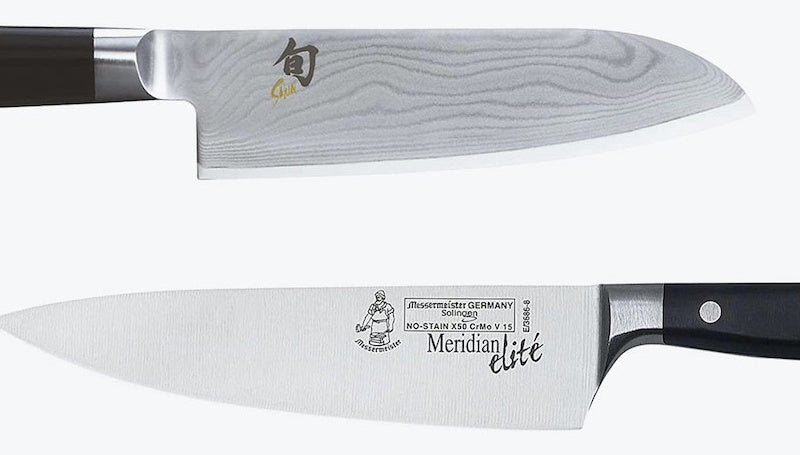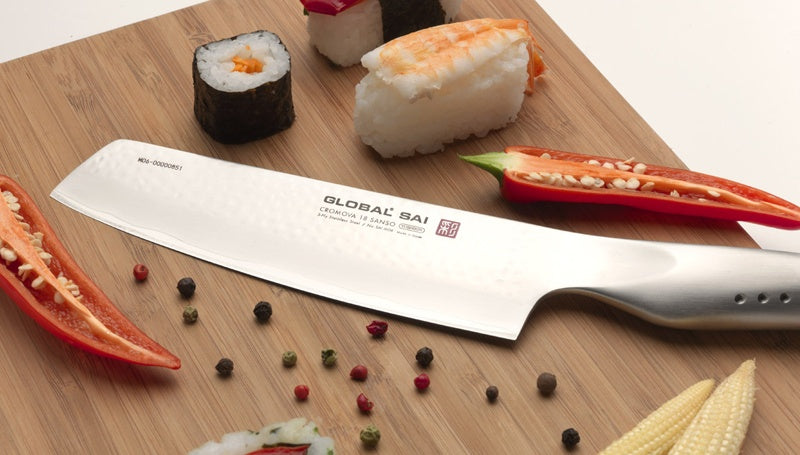FREE SHIPPING ACROSS THE UK
5 STAR CUSTOMER REVIEWS ⭐️⭐️⭐️⭐️⭐️
SHARPNESS GUARANTEED
FREE SHIPPING ACROSS THE UK
5 STAR CUSTOMER REVIEWS ⭐️⭐️⭐️⭐️⭐️
SHARPNESS GUARANTEED
Add description, images, menus and links to your mega menu
A column with no settings can be used as a spacer
Link to your collections, sales and even external links
Add up to five columns
Add description, images, menus and links to your mega menu
A column with no settings can be used as a spacer
Link to your collections, sales and even external links
Add up to five columns
Japanese Knives Vs European Knives: What are the differences?
June 24, 2020 3 min read

If you are looking to buy a high-quality knife, one of the first choices you will have to make is deciding between a Japanese knife or a European, or being more specific German, knife. It can be quite confusing especially when you start coming across terms such as Gyuto, Santoku, Bunka, and Nakiri. It can all get a bit too much! While there are lots of other types of knives out there, we can safely say that Japanese and German knives are the most prevalent type of high-end knives we come across here at Knife Sharp.
One thing to note is that if you are looking for a Japanese knife sharpening service you have come to the right place as Knife Sharp can sharpen and repair all styles of Japanese knives, including single bevel blades. We have a vast amount of experience in looking after Japanese knives. Take a look at our professional knife sharpening and repair service for more details.
Nowadays if you are buying a knife from a reputable manufacturer such as Global you can’t really go wrong with either type of knife, however, one style of knife may be better suited to you depending on what you are looking to use it for, or your preferences. Let’s take a look at the main differences between the two…
Japanese Knife Specs
- The angle of the blade is around 10 to 16 degrees and is often only on one side of the blade (single bevel)
- The blade is thin, very sharp, and most of the time don't have bolsters
- The steel is very hard, often over 62 HrC Rockwell which is similar to hardened tool steels
- The shape of the knife is typically straighter, more suited to slicing
- They are light and very well balanced
- Due to the sharpness and steel hardness, they can be prone to damage such as chips
European (German) Knife Specs
- The angle of the blade is around 17 to 20 degrees and is on both sides of the blade (double bevel)
- The blade is thicker, more robust especially towards the bolster which they often have.
- The hardness of the steel can vary but typically they are softer than Japanese knives at around 55 to 60 HrC Rockwell
- The shape of the knives are more curved which helps with chopping using the rocking technique
- They are typically heavier when compared to Japanese knives, giving a more weighty feeling in the hand. The balance point of the knife is often more towards the handle
- They are very robust but can dull quicker than Japanese knives due to the softer steel.
As you can see some significant difference do exist, but in terms of choosing the right knife for you, it very much depends on your personal preferences and what you are using the knife for. Like a nice weighty knife? Go for a European one. Looking to do precise fine slicing? A Japanese knife is where it's at. Don’t want to be worried about chipping the knife in everyday use? The European knife will take a lot more abuse.
Overall, unless you have specific needs or a strong preference to one style over another, it's not that important which style you go for. The differences between the two are getting smaller as manufacturers are blending the qualities of the two blades into hybrid knives that offer the best of both worlds. So our advice for most people is pick what you like best!
Remember our professional knife sharpening and repair service covers both Japanese knife sharpening and European knife sharpening so whatever option you go for we can look after your knives for you.
Stay Sharp!
Also in The 'Sharp' Blog

Now Accepting Klarna & USDC Stablecoin
December 16, 2025 2 min read
At Knife Sharp, we’re always looking for ways to make your experience with us smoother, faster, and more flexible. That’s why we’re excited to announce that we now accept both Klarna and USDC stablecoin as payment methods...

Now Offering Delivery via Royal Mail
September 10, 2025 2 min read
At Knife Sharp, we’re always looking for ways to make life easier (and sharper!) for our customers, we are very proud to say that we now offer delivery via Royal Mail, using the tracked and insured, next day delivery service, Royal Mail Tracked 24®...

Identifying fake & counterfeit Global knives
May 01, 2024 3 min read
Here at Knife Sharp, we sharpen hundreds of Global knives every week. We love them as they are high quality and hold a fantastic sharp edge. However more recently we have been seeing more and more fake Global knives come to us...
Read More
